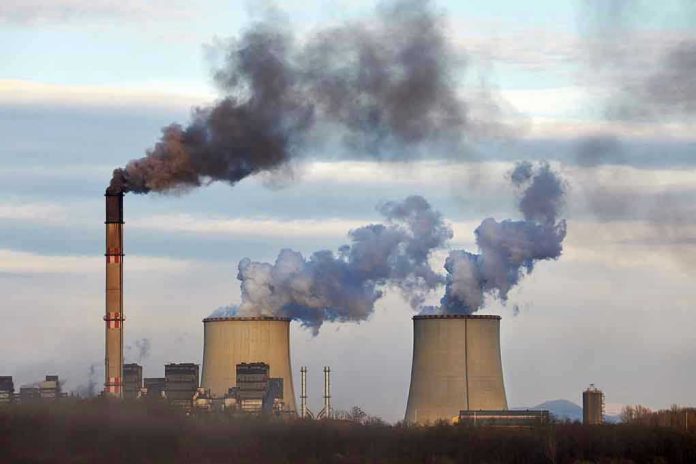
Hundreds of Oklahomans found themselves gasping for air and scrambling for safety when a routine fertilizer delivery turned into a toxic nightmare—exposing how close any of us can come to disaster just by checking into the wrong hotel at the wrong time.
Story Snapshot
- A tanker truck’s ammonia leak forced the evacuation of hundreds in Weatherford, Oklahoma, and sent dozens to the hospital.
- The incident revealed critical gaps in hazardous materials transport safety and emergency response in small towns.
- Slow-moving gas and calm winds prolonged the crisis, keeping air quality dangerous for hours.
- Health, regulations, and corporate responsibility now face sharp scrutiny in the aftermath.
How a Fertilizer Delivery Became Oklahoma’s Latest Public Health Emergency
When a tanker truck loaded with anhydrous ammonia parked in a hotel lot in Weatherford, Oklahoma, on November 12, 2025, few could have imagined that within hours, a noxious cloud would blanket the area, sending panic through a town of 12,000. The leak began around 10 p.m., unleashing a wave of respiratory distress that would hospitalize at least 36 people and force hundreds to flee their homes or shelter behind sealed doors and windows. Local emergency services, backed by the Oklahoma National Guard and specialized hazmat teams, rushed to contain the gas and monitor the air—while the community faced a sleepless, breathless night.
Airborne ammonia, invisible but potent, crept through neighborhoods and businesses, stymied only by the windless night that allowed the toxic plume to linger. Interstate 40’s Weatherford exit closed, businesses and schools locked their doors, and an estimated 500 to 600 people spent the night in makeshift shelters. Nursing homes, already charged with caring for the town’s most vulnerable, faced an unthinkable challenge: protecting residents from a chemical that can burn lungs and eyes in seconds. As the first responders triaged the sick and secured the leak, questions began to swirl about why such hazardous cargo was parked in the heart of town, and whether disaster protocols were truly up to the threat.
The Chemical Behind the Crisis: Anhydrous Ammonia’s Double-Edged Role
Anhydrous ammonia is a backbone of modern agriculture, essential for fertilizing America’s corn and wheat fields. Its journey from factory to farm, however, is fraught with risk. Transported under pressure as a liquid, it becomes a choking gas at ambient temperatures—a fact that proved all too real in Weatherford’s hotel parking lot. Exposure can cause immediate breathing problems, chemical burns, and, in high enough concentrations, death. The routine movement of this substance through rural communities is a calculated gamble: essential for food production, perilous if protocols falter. In this case, routine took a sharp turn into emergency, shining a harsh light on the thin margin separating everyday life from industrial catastrophe.
For Oklahoma, this event was not an isolated fluke. Just a week prior, a similar ammonia leak in Mississippi had prompted evacuations and hospitalizations, suggesting a disturbing pattern. While industry voices highlight the rarity of such incidents relative to the volume transported, recent headlines say otherwise. For the families forced from their homes and the dozens seeking medical care, statistical reassurance rings hollow. The incident has reignited debate over whether hazardous materials should be routed away from population centers altogether, or if simply tightening safety standards and driver protocols would suffice.
Community Fallout, Policy Reckoning, and the Search for Accountability
As dawn broke on November 13, Weatherford’s ordeal was far from over. While hazmat crews finally stopped the leak, the invisible threat lingered: air quality remained poor, and authorities kept shelters open and businesses closed. The incident’s ripple effects were immediate—schools and nursing homes shuttered, businesses idled, and hundreds of families displaced. The economic cost is still being tallied, but the human toll was already clear. Emergency response drew praise for quick mobilization, but also tough questions: why was a dangerous chemical truck allowed to park in a public lot, and were local responders equipped for a leak of this scale?
Scrutiny now shifts to the trucking company, whose liability and compliance with hazardous material regulations are under investigation. Local and state officials face demands for stronger oversight and preparedness. Industry experts warn that anhydrous ammonia, while essential, is unforgiving of error—underscoring the need for robust safety protocols. Health professionals, especially those caring for the elderly and children, emphasize the acute risk such leaks pose to vulnerable populations. In Weatherford, the memory of that night—sirens wailing, air thick with poison—will not fade quickly. Nor will the public’s demand for answers, accountability, and change.
Sources:
Arab News: Hundreds evacuated and dozens hospitalized after an ammonia gas leak in Oklahoma
iHeartRadio: Dozens Hospitalized In Oklahoma After An Ammonia Gas Leak













